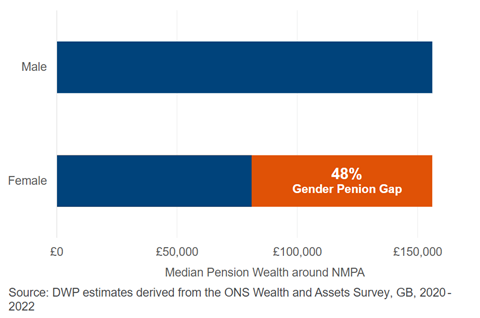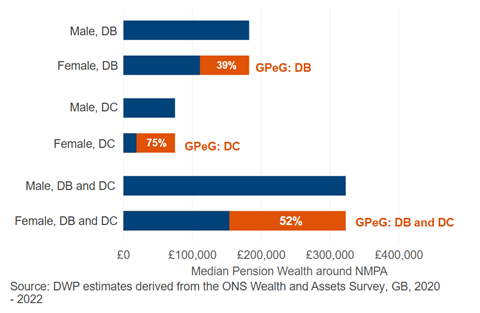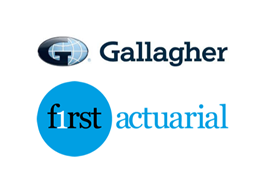The government’s latest figures reveal a 48% gender pensions gap among those nearing retirement. Experts say the new Pensions Commission must address systemic inequalities and act fast to prevent a deepening crisis, as Sara Benwell reports.
Official figures confirm a wide and persistent gender pensions gap, prompting industry experts to call for bold reform and urgent action from the new Pensions Commission.
A Department for Work and Pensions (DWP) report, published alongside the launch of the commission this week, revealed a 48% gap in private pension wealth between men and women approaching retirement. When including those with no pension savings, that gap increases to 62%.
It found that women aged 55 to 59 hold median private pension pots worth £81,000, whereas the equivalent men had savings of £156,000. This leaves women with private pension incomes of just over £100 a week, compared to more than £200 a week for men.

Meanwhile, Royal London’s most recent Financial Resilience Report found that men have an average of £92,000 in their pension pots, while women have only £39,000. In addition, more than half (54%) of women say they do not feel confident when saving for retirement, compared to 41% of men.
Separate DWP figures show that 43% of working-age people – equivalent to 14.6 million individuals – are not saving enough for retirement to achieve an adequate income. Higher earners are particularly affected, with almost half of those earning over £67,000 falling short of their target replacement rates.

A complex web of inequalities
The DWP analysis identifies a range of drivers behind the gender pensions gap, including lower average earnings for women, time spent out of the workforce due to caring responsibilities, and greater likelihood of part-time or lower-paid work.
One common issue is that many women work multiple part-time roles, each of which falls under the £10,000 earnings threshold for automatic enrolment. Despite working the equivalent of full-time hours, these individuals can be excluded from workplace pensions altogether.
“The gender pay gap disadvantages women’s future finances because it means they are more likely to be contributing less to their retirement savings than their male peers.”
Catherine Foot, Standard Life Centre for the Future of Retirement
The gender pay gap also compounds over time, translating into significantly lower pension contributions and savings. This disparity is made worse by typical events that happen over the course of a woman’s life, such as motherhood, divorce and caring responsibilities.
As Catherine Foot, director of the Standard Life Centre for the Future of Retirement, explains: “The gender pay gap disadvantages women’s future finances because it means they are more likely to be contributing less to their retirement savings than their male peers… The values of workplace pension contributions diverge between men and women at 25 to 34, and the gap widens with age.”
Other under-pensioned groups highlighted in the government analysis include disabled workers, Pakistani and Bangladeshi communities, carers, and renters – the latter of whom now make up a quarter of workers aged over 55. The self-employed, who remain excluded from automatic enrolment, also face significant retirement shortfalls.

What next for policy?
While automatic enrolment has improved overall participation, minimum contributions remain too low to deliver adequate retirement outcomes for most people. Contributions are particularly low among part-time and lower-paid workers, many of whom are women. Despite this, the government has ruled out increases to minimum contributions in this parliament.
Paul Leandro, partner at Barnett Waddingham, warns that time is running out: “The ambition to explore the barriers stopping people from saving enough for retirement is needed, but work on this already done by the industry needs to be recognised. A final report in 2027 means at least another two-year delay before solutions will be implemented, [which] pushes the timebomb closer to detonation.”
Kate Smith, head of pensions at Aegon, adds that addressing inequality will require political bravery and unpalatable recommendations, such as implementing significant increases to auto-enrolment contributions during the next parliament for those on middle and higher incomes.
“We’re disappointed there is no mention of the 2017 reforms to auto-enrolment. Implementing these could go some way to removing pension inequalities.”
Kate Smith, Aegon
She notes that affordability challenges are often linked to wider labour market dynamics. “These are not issues that can be addressed by pensions policy alone,” Smith adds. “We’re disappointed there is no mention of the 2017 reforms to auto-enrolment. Implementing these could go some way to removing pension inequalities.”
Royal London’s director of policy Jamie Jenkins cautions that now might not be the time to raise contribution levels, given other financial pressures. However, he adds that the government will likely need to act sooner, rather than later. He explains: “We need certainty on the long-term direction of travel for private and state pensions and to ensure the system works well for everyone.”
Lisa Picardo, chief business officer at PensionBee, warns that, without bold reform, millions – including carers, the self-employed, women and low-paid workers – risk sleepwalking into retirement poverty.
She concludes: “The challenges highlighted [by government data] – from the gender pensions gap to the chronic under-saving of the self-employed, lower-paid and certain ethnic groups – are not new, but they are growing. These are issues we’ve been drawing attention to for some time, and the data shows the consequences of continued inaction.”






















